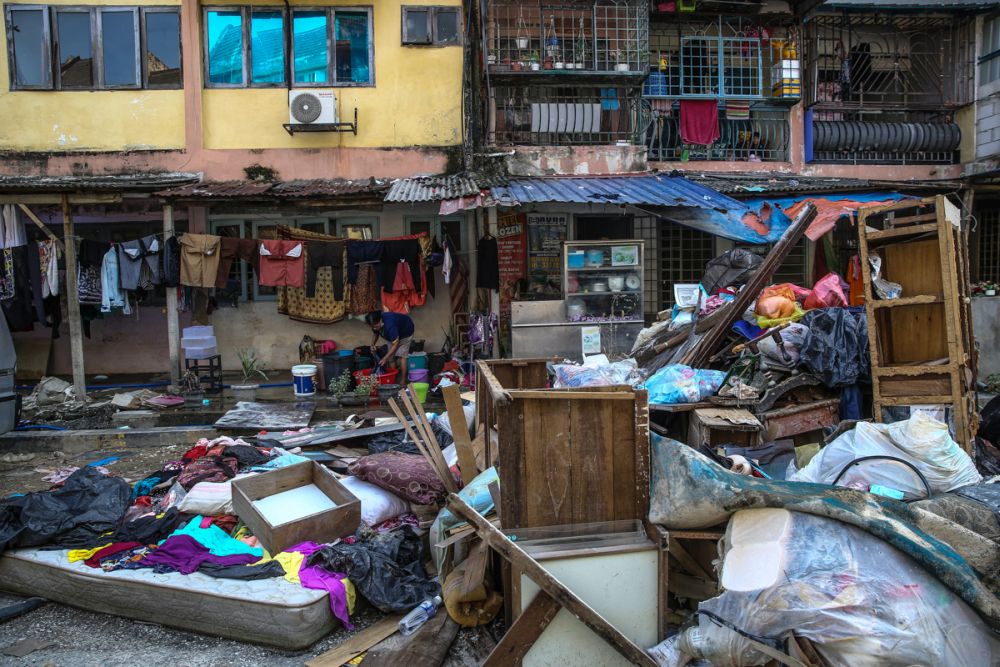A woman does her laundry outside her home in Taman Sri Muda, Shah Alam December 29, 2021. — Picture by Yusof Mat Isa
KUALA LUMPUR, Dec 30 — Clad in her mud-spattered shorts and T-shirt, Derismawa Arisno sat on her 42-inch flat television as she took a break from cleaning up the single-storey house which she shares with her two housemates.
The relatively new TV used to adorn her living room. Now, it is good for nothing more than serving as a makeshift chair after being submerged in floodwaters from Dec 18 to 25. Surrounding it and Derismawa were sodden curtains, mud-soaked clothes and a muddy bag of rice, and remnants of furniture that have turned into mush and wood pulp.
“When we got home from work, the water had already entered the house. We could only get some clothes. Everything else is gone. We were all panicking,” she said.
Amidst the ruins, she and other residents question why there was no warning and how the floods got so bad. Kampung Tengah in Banting, where she lives, is a working-class neighborhood, with most of the residents working at the Kuala Lumpur International Airport nearby. Surrounded by oil palm plantations, it does not usually flood there, residents said.
Forty-four kilometres north, in Taman Sri Muda in Shah Alam, Raynugadewi Subramaniam, who prefers to be called Raynu, wondered the same thing. Like Derismawa, she said she was completely blindsided by the floods. Unlike Kampung Tengah, her neighborhood is prone to slight flooding every time it rains heavily, which she termed as “not that bad”.
On the morning of Dec 18, however, she noticed the water was rushing in faster than normal, which is why she and her mother left the house to park their car on a hill.
“It was quite hard but thank God we managed to get to a higher area,” she told Bernama via WhatsApp. “We waited for the water to subside a little bit so we could actually walk back to the house, but then I realised the water level was rising higher.”
Cut off from their house, she and her mother had to seek dry land, leaving behind all their possessions and their cat. (The cat is fine. It was rescued three days later.)
She returned on Dec 23 to find everything on the first floor, including some precious memorabilia, destroyed and her neighbourhood looking like “a war zone”.
As of Dec 27, the floods claimed 25 lives in Selangor, including two volunteers, while tens of thousands of people were displaced. Hundreds were reportedly stranded on the roofs or the upper floors of their houses without food or electricity for over a day.
Overcapacity
Ironically, Selangor is the state deemed most prepared for a disaster in Malaysia by the United Nations, according to disaster preparedness expert Dr Khamarrul Azahari Razak.
So what happened?
“What happened was the impact of climate change and an extreme weather event on that day (Dec 18). Keep in mind Met Malaysia (Malaysian Meteorological Department) had issued the warning, and… (the change in weather) came within a short space of time,” he said.
He added experts, including him, had been focusing on northeastern coastal states, expecting the rain to fall over them as it usually did, when the system went southwest to the Klang Valley instead.
Officials blame the floods on the amount of rainfall — over 300mm of rain fell in a day which was equivalent to the average rainfall for a whole month. Coupled with high tides, low-lying regions, full rivers and over-saturated earth, the combo proved too much for current flood mitigation measures to cope with.
While climate scientists and local experts have predicted more rainfall and flooding in this region in the future, including in zones that don’t usually flood, the Dec 18 floods still took many experts by surprise.
“To be honest, in my 30-odd years of service, I have not seen any flood similar to the one in Kuala Langat over the last week. Shah Alam too,” National Water Research Institute director-general Datuk Nor Hisham Mohd Ghazali told Bernama via WhatsApp.
While the public is used to some flooding in the low-lying areas of the Klang Valley and Selangor, especially near rivers, few expected the areas to remain flooded days after the rain stopped.
It took a week for the water to subside in Kampung Tengah in Banting. In Taman Sri Muda, the authorities had to employ emergency mobile pumps to drain the water, allowing residents to return five days later to clean up their homes.
River and drainage expert Dr Kalithasan Kailasam of Global Environment Centre (GEC) said the monsoon season meant rivers and dams are full, which makes it hard for the water to drain and, hence, it backtracks to the houses.
“It’s a backflow,” he said.
Considering the amount of rain that fell on Dec 18 and 19 was almost twice December’s average rainfall, future water catchment projects would have to be able to contain 300-400mm of water at any given time, said Selangor Mentri Besar Datuk Seri Amirudin Shari on Dec 27.
The public is now asking what is being done to prevent a repeat of the 2021 Klang Valley floods with regard to mitigation and response.
Preparing for the future
There are two parts to flood mitigation: one is structural and the other is non-structural. Experts said increasing structural flood mitigation measures, such as the number and capacity of retention ponds, dams, levees and diversion channels, will help the Klang Valley and the rest of Malaysia to face the climate change threat.
As for non-structural solutions, experts and members of the public said the state and federal governments should improve their disaster response and management plans.
Raynu said as far as she knew, volunteers rescued stranded neighbours and friends at Taman Sri Muda, not the government.
“This could have been avoided or better managed by the authorities. I feel like this is a big failure on their part,” she said.
A 2020 report on Disaster Risk Reduction in Malaysia by the UN Office for Disaster Risk Reduction and Asian Disaster Preparedness Centre described the country’s centralised or top-down disaster management system as inefficient and obsolete.
” it is inevitable that inflexibility (of the top-down disaster management system) renders them obsolete when facing the challenges of the 21st century where ‘bottom-up’ information plays an important role with the revolution of social media and awareness among the public impacting the government’s reputation and goodwill,” it said.
Dr Khamarrul, who is also an exco member of Mercy Malaysia, recommended a decentralised system, saying effective disaster management means bringing local and state authorities into the fold.
“If you strengthen the local government — the state, local councils, local municipal councils — actually you improve the entire machinery of the entire disaster management scheme, instead of you just focusing on Nadmda (National Disaster Management Agency),” he said.
Nadma was formed in 2015. On Oct 5 this year, its director-general Datuk Dr Aminuddin Hassim said the agency was formulating a risk reduction policy. He did not respond to requests for updates on the policy.
The “bottom-up” approach should also include the public.
Dr Kalithasan, who is the River Care Manager for GEC, hoped the floods would also serve as a wake-up call for the public, saying they play a very important role in managing and preparing for disasters.
“We have to follow the 2021 climate change model where it’s unpredictable. We have the possibility (that it will) flood anywhere. It can happen anytime not follow the monsoon like last time when (only) Kelantan, Terengganu will flood in December,” he said.
Coming together
Experts said other non-structural changes include banning development on floodplains, ensuring sustainable development by working with nature, and strengthening regulations and implementing stringent requirements.
Nor Hisham, who is also the former director-general of the Department of Irrigation and Drainage Malaysia, said there should not be any development in floodplains.
“In some areas, why build in the first place?” he asked.
But if there is a need to develop, experts said the requirements should anticipate the effects of climate change, such as higher rainfall and extreme weather events. There should be tighter curbs on deforestation. The authorities should also not compromise on regulations and not approve any development that fails to meet the requirements.
Environmental management expert Associate Prof Dr Mohd Khairul Amri Kamaruddin of Universiti Sultan Zainal Abidin told Bernama development need not stop, but could instead work together with conservation efforts.
“We take care of it (nature). We develop areas for ecotourism so we can get money to benefit local communities,” he said.
Nor Hisham agreed, saying whatever development that is done should not interfere with the hydrological process or natural processes of the river.
“So this jelling of development and nature – where the natural system is not interfered with but the human community can also thrive – must happen. And in a country that gets so much rain like ours, it’s crucial for the future,” he said. — Bernama



